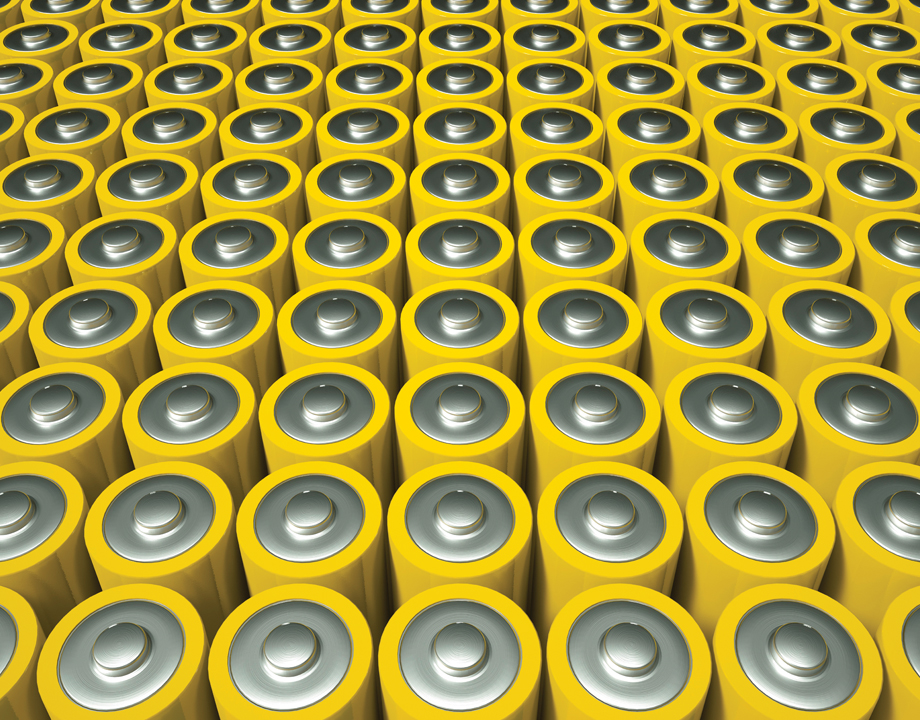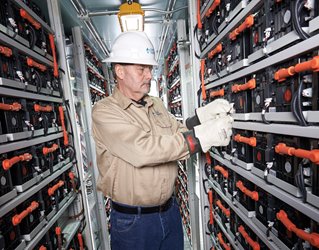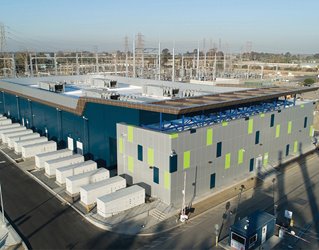Renewable-Heavy Grids Need Watts in Store
Renewable-Heavy Grids Need Watts in Store


Making renewable energy work as well for the grid as fossil fuels do requires lots of long-term electricity storage. Various companies are pursuing that multibillion-dollar opportunity.
Governments and industries have set very aggressive decarbonization goals that will come due over the next decade. Those goals have put utilities, grid operators, regulators, and electric power industry vendors under pressure to meet them.
One way to do that is through adding renewable power sources, mostly wind and solar. Based on current trends and regulations, the U.S. Energy Information Administration projects the share of renewables in the U.S. will jump from 21 percent in 2020 to 42 percent in 2050. By 2030, wind and solar will collectively pass natural gas to become the dominant source of electricity generation in the U.S.
However, the intermittency of wind and solar power across multiple timescales—minute by minute, hour by hour, and across days and seasons—is raising questions about availability.
Short-term electricity storage is well covered. Lithium-ion batteries are reliable and getting progressively cheaper, but generally deliver full power capacity for no more than four hours. One of the biggest deployments of lithium-ion battery storage occurred in 2017, after a series of regional blackouts in South Australia. Tesla stepped in with a 100-MW battery bank, able to power more than 30,000 homes for an hour.
That project worked well enough that the Australian Energy Market Operator in 2020 awarded a contract to developer Neoen to build a 300-MW, 450-MWh plant along a transmission line connecting Victoria and New South Wales, using Tesla’s batteries. Interestingly, it will act as transmission infrastructure, guaranteeing on-demand power if the network has an unexpected outage. That would help AEMO move another 250 MW of peak capacity between the states and help balance renewable power production.
But for renewable energy to fully replace fossil fuels, energy storage systems must advance to provide long and longer-term storage capability, and then deliver it on demand.
There are a variety of technologies being developed for long-term storage, defined loosely as anything over four hours to seasonal, although the near-term need is generally recognized as six to 12 hours.
Selected for You: Heated Volcanic Rocks Store Energy
“That ten to twelve-hour period is sort of a sweet spot right now,” said Tom Fenimore, director of emerging technology at Duke Energy. “That’s really one of the challenges that we’ve got around these technologies for this kind of long-duration storage that we’re looking for. There are hundreds of megawatts (needed) and gigawatt-scale technologies are what we’re interested in. And there are very few deployments of anything but lithium-ion at that scale to date. From a technology maturity perspective, we’re very early on.”
For the new electric grid to operate efficiently with the increasing loads of renewable power, these other technologies will need to be deployed. Fenimore and others said there is no single technology to rely upon, but a smorgasbord of solutions still being tweaked, along with at least two proven alternatives.
Long-term energy storage sounds exotic, but it can be as simple as pumping water uphill. Pumped storage hydro is the oldest energy storage system (a system was built in Switzerland in 1907). Its operation is simple. Water moves between two reservoirs at different elevations. During times of peak demand, it is released from the upper reservoir through penstocks to power electric turbines at the base of the lower reservoir. Later, it pumped back to the upper reservoir for use as needed.
The U.S. had 22.9 GW of pumped hydro capacity in 2020. The Department of Energy reports the technology currently accounts for 95 percent of all utility-scale energy storage in the U.S.
Geologic conditions limit its expansion, however, along with opposition to siting large projects. The Federal Energy Regulatory Commission issued three permits for proposed projects since 2014, but there has not been a new project to come online in the U.S. since 2012.
“Gigawatts of pumped hydro has been in place for many decades around the world,” said Haresh Kamath, director of distributed energy resources and energy storage at the Electric Power Research Institute. “But it is a bit difficult to site.”
Other gravitational technologies may be easier to implement. Energy Vault, based in Lugano, Switzerland, uses proprietary technology based on pumped hydro to autonomously lift and lower a system built upon 30-ton bricks. Designed to work with renewable energy sources, its software raises the bricks to elevation when power generation is high and lowers them using gravity when power is needed. The firm claims the system is economically viable for short-term and long-term durations, of four to 12 hours, and can be built in 10-MWh increments.
The company has been operating a pilot plant is Switzerland that is grid-connected and recently announced an agreement with DG Fuels LLC, a California firm that produces renewable hydrogen and synthetic aviation and diesel fuel. Energy Vault will provide 1.6 GWh of energy storage to support multiple projects, and the storage system will work in conjunction with photovoltaic solar power stations to match the demand load for green hydrogen production.
“There’s a couple [technologies] in the gravitational area that we’re interested in,” said Fenimore. “It’ll be interesting to see how that technology works in the first few systems they deploy in the U.S.”
Compressed air systems also hold potential, though only four plants are operating in the world, including the first, a 290-MW project built in 1978 in Germany.
Hydrostor is one firm seeking to expand the technology using a patented compressed air system that operates like a giant battery.
Compressed air energy storage systems commonly use natural gas to run a compressor that produces heated compressed air. Hyrdrostor’s process uses off-peak renewable energy to run a compressor and captures heat from the compression process and holds it in a proprietary storage system. Compressed air is sent underground through pipes to a purpose-build cavern. When power is needed, hydrostatic pressure forces air to the surface where it recombined with the stored heat and expanded through a turbine to produce electricity.
Company officials said the technology is cost-effective for a range of 200 MW to more than 500 MW and a duration of four to six hours or more. They are now developing two projects in California, where regulators have identified energy storage as a means of meeting decarbonization goals. The California Public Utilities Commission last year recommended the state procure 1 GW of storage with a minimum duration of eight hours to compensate for the upcoming closure of the Diablo Canyon nuclear power plant.
Between 2021 and 2035, U.S. utilities also will shutter some 93 GW of coal-fired generation, according to S&P Global Market Intelligence. Converting those facilities into clean-energy storage would support buildout of renewable energy and reuse existing infrastructure.
Xcel Energy Inc. is considering retrofitting one unit of a coal plant in northwestern Colorado with an energy storage system using molten salt. In North Carolina, Duke Energy is investigating the technology with startup Malta Inc., preparing to retire 6,370 MW of coal-fired capacity between 2021 and 2028.
Editor's Choice: Test Your Knowledge of Energy Storage
Malta’s system stores electricity from a power plant or the grid via a heat pump, creating a difference in temperature between the two sides of the system. The hot side raises the temperature of a tank of molten salt, while the cold side refrigerates an antifreeze-like solution derived from the liquefied natural gas industry. In discharge, it operates as a heat engine as thermal energy moves from hot to cold.
Besides its pilot project with Duke Energy, Malta is working with NB Power in New Brunswick, Canada, to deliver a 1,000-MWh storage facility, and is partnering with engineering giant Bechtel to build its systems for grid-scale applications.
“This is a pilot proof-of-concept type testing,” Duke’s Fenimore said. “That’s one of the challenges around these technologies for long-duration storage: There are very few deployments.”
Flow batteries, however, are beginning to make an appearance in energy storage. Flow batteries generate and store electricity using two types of treated electrolyte. An electrical charge takes place when the electrolytes flow across either side of a membrane. Ions crossing the membrane in one direction charge the battery. When they cross the other way, electricity discharges.
The most promising flow batteries have used vanadium, a rare earth metal found mostly in Russia. But its costs rise and fall on the mineral’s availability. Lower-cost options are being developed using zinc and iron.
New Jersey-based Eos is developing its zinc-hybrid battery that may compete with lithium-ion for short-term storage or seep into the longer-term market. Each cell uses a carbon felt cathode that plates zinc onto a ceramic-coated titanium current collector sitting in an electrolyte solution. It is a static system and does not need an HVAC system to maintain safe operating temperatures, unlike lithium-ion systems. Iron flow batteries are not new and have some advantages in materials cost, but the technology has suffered from excess hydrogen generation on the negative electrode that contributes to cell failure. To combat that, Wilsonville, Ore.-based ESS Inc. developed what it calls a proton pump.
More on Energy Storage: Storing Heat from Nuclear Power Plants Could Improve Output
“It really keeps the battery in balance,” said Craig Evans, ESS president and founder. “During charging, you tend to see protons streaming from the positive side of the battery to the negative side, which is counter to what we want. We think of the proton pump as the kidney of the system. We basically take that hydrogen that has evolved from the negative side of the battery and bring it back over to the positive side. It brings the state of charge back in balance.”
The company claims its batteries will last 20 years or more without capacity fade or degradation. That was enough to impress Munich RE, a global reinsurance provider. Last year, the firm announced expanded coverage of a 10-year warranty insurance coverage for the flow battery technology as well as the electrolyte system. ESS recently put the first of its batteries online in a deal with SB Energy at its solar power plant in Davis, Calif. Both ESS and Eos raised significant capital last year, going public by merging with a special-purpose acquisition company. ESS should realize some $465 million, which it will use to expand its existing production facility.
As these technologies develop, it is likely utilities will employ a mix based on their own unique needs and locations. National Renewable Energy Laboratory researchers developed a model to compare energy storage combinations across the U.S. in a storage scenario for a system with 100 percent renewable sources. An ideal energy storage system may look markedly different from one region to another, varying with the percentage of renewable energy sources, said Omar Guerra, an NREL researcher who helped develop the model.
Different systems face fundamental tradeoffs in capital costs and efficiencies, making multiple technologies useful. Development will depend on policies and deadlines, noted Guerra, as well as regulations that will drive investment. And that should happen sooner than later.
“Over the next three to four years we’ve got a roughly $500-million scope of projects that are outlines to be deployed, on our distribution side,” Fenimore said. “But those numbers are going to change depending on the impact of what we see from Washington. The states have been asking us to move [plans] up aggressively, for our reduction in our carbon footprint. I really see this going hockey stick very, very quickly.”
John Kosowatz is senior editor.
One way to do that is through adding renewable power sources, mostly wind and solar. Based on current trends and regulations, the U.S. Energy Information Administration projects the share of renewables in the U.S. will jump from 21 percent in 2020 to 42 percent in 2050. By 2030, wind and solar will collectively pass natural gas to become the dominant source of electricity generation in the U.S.
However, the intermittency of wind and solar power across multiple timescales—minute by minute, hour by hour, and across days and seasons—is raising questions about availability.
Short-term electricity storage is well covered. Lithium-ion batteries are reliable and getting progressively cheaper, but generally deliver full power capacity for no more than four hours. One of the biggest deployments of lithium-ion battery storage occurred in 2017, after a series of regional blackouts in South Australia. Tesla stepped in with a 100-MW battery bank, able to power more than 30,000 homes for an hour.
That project worked well enough that the Australian Energy Market Operator in 2020 awarded a contract to developer Neoen to build a 300-MW, 450-MWh plant along a transmission line connecting Victoria and New South Wales, using Tesla’s batteries. Interestingly, it will act as transmission infrastructure, guaranteeing on-demand power if the network has an unexpected outage. That would help AEMO move another 250 MW of peak capacity between the states and help balance renewable power production.
But for renewable energy to fully replace fossil fuels, energy storage systems must advance to provide long and longer-term storage capability, and then deliver it on demand.
There are a variety of technologies being developed for long-term storage, defined loosely as anything over four hours to seasonal, although the near-term need is generally recognized as six to 12 hours.
Selected for You: Heated Volcanic Rocks Store Energy
“That ten to twelve-hour period is sort of a sweet spot right now,” said Tom Fenimore, director of emerging technology at Duke Energy. “That’s really one of the challenges that we’ve got around these technologies for this kind of long-duration storage that we’re looking for. There are hundreds of megawatts (needed) and gigawatt-scale technologies are what we’re interested in. And there are very few deployments of anything but lithium-ion at that scale to date. From a technology maturity perspective, we’re very early on.”
For the new electric grid to operate efficiently with the increasing loads of renewable power, these other technologies will need to be deployed. Fenimore and others said there is no single technology to rely upon, but a smorgasbord of solutions still being tweaked, along with at least two proven alternatives.
Reliable and Proven
Long-term energy storage sounds exotic, but it can be as simple as pumping water uphill. Pumped storage hydro is the oldest energy storage system (a system was built in Switzerland in 1907). Its operation is simple. Water moves between two reservoirs at different elevations. During times of peak demand, it is released from the upper reservoir through penstocks to power electric turbines at the base of the lower reservoir. Later, it pumped back to the upper reservoir for use as needed.
The U.S. had 22.9 GW of pumped hydro capacity in 2020. The Department of Energy reports the technology currently accounts for 95 percent of all utility-scale energy storage in the U.S.
Geologic conditions limit its expansion, however, along with opposition to siting large projects. The Federal Energy Regulatory Commission issued three permits for proposed projects since 2014, but there has not been a new project to come online in the U.S. since 2012.
“Gigawatts of pumped hydro has been in place for many decades around the world,” said Haresh Kamath, director of distributed energy resources and energy storage at the Electric Power Research Institute. “But it is a bit difficult to site.”
Other gravitational technologies may be easier to implement. Energy Vault, based in Lugano, Switzerland, uses proprietary technology based on pumped hydro to autonomously lift and lower a system built upon 30-ton bricks. Designed to work with renewable energy sources, its software raises the bricks to elevation when power generation is high and lowers them using gravity when power is needed. The firm claims the system is economically viable for short-term and long-term durations, of four to 12 hours, and can be built in 10-MWh increments.
The company has been operating a pilot plant is Switzerland that is grid-connected and recently announced an agreement with DG Fuels LLC, a California firm that produces renewable hydrogen and synthetic aviation and diesel fuel. Energy Vault will provide 1.6 GWh of energy storage to support multiple projects, and the storage system will work in conjunction with photovoltaic solar power stations to match the demand load for green hydrogen production.
“There’s a couple [technologies] in the gravitational area that we’re interested in,” said Fenimore. “It’ll be interesting to see how that technology works in the first few systems they deploy in the U.S.”
Compressed air systems also hold potential, though only four plants are operating in the world, including the first, a 290-MW project built in 1978 in Germany.
Hydrostor is one firm seeking to expand the technology using a patented compressed air system that operates like a giant battery.
Compressed air energy storage systems commonly use natural gas to run a compressor that produces heated compressed air. Hyrdrostor’s process uses off-peak renewable energy to run a compressor and captures heat from the compression process and holds it in a proprietary storage system. Compressed air is sent underground through pipes to a purpose-build cavern. When power is needed, hydrostatic pressure forces air to the surface where it recombined with the stored heat and expanded through a turbine to produce electricity.
Company officials said the technology is cost-effective for a range of 200 MW to more than 500 MW and a duration of four to six hours or more. They are now developing two projects in California, where regulators have identified energy storage as a means of meeting decarbonization goals. The California Public Utilities Commission last year recommended the state procure 1 GW of storage with a minimum duration of eight hours to compensate for the upcoming closure of the Diablo Canyon nuclear power plant.
Repurposing Coal Plants
Between 2021 and 2035, U.S. utilities also will shutter some 93 GW of coal-fired generation, according to S&P Global Market Intelligence. Converting those facilities into clean-energy storage would support buildout of renewable energy and reuse existing infrastructure.
Xcel Energy Inc. is considering retrofitting one unit of a coal plant in northwestern Colorado with an energy storage system using molten salt. In North Carolina, Duke Energy is investigating the technology with startup Malta Inc., preparing to retire 6,370 MW of coal-fired capacity between 2021 and 2028.
Editor's Choice: Test Your Knowledge of Energy Storage
Malta’s system stores electricity from a power plant or the grid via a heat pump, creating a difference in temperature between the two sides of the system. The hot side raises the temperature of a tank of molten salt, while the cold side refrigerates an antifreeze-like solution derived from the liquefied natural gas industry. In discharge, it operates as a heat engine as thermal energy moves from hot to cold.
Besides its pilot project with Duke Energy, Malta is working with NB Power in New Brunswick, Canada, to deliver a 1,000-MWh storage facility, and is partnering with engineering giant Bechtel to build its systems for grid-scale applications.
“This is a pilot proof-of-concept type testing,” Duke’s Fenimore said. “That’s one of the challenges around these technologies for long-duration storage: There are very few deployments.”
Flow batteries, however, are beginning to make an appearance in energy storage. Flow batteries generate and store electricity using two types of treated electrolyte. An electrical charge takes place when the electrolytes flow across either side of a membrane. Ions crossing the membrane in one direction charge the battery. When they cross the other way, electricity discharges.
The most promising flow batteries have used vanadium, a rare earth metal found mostly in Russia. But its costs rise and fall on the mineral’s availability. Lower-cost options are being developed using zinc and iron.
New Jersey-based Eos is developing its zinc-hybrid battery that may compete with lithium-ion for short-term storage or seep into the longer-term market. Each cell uses a carbon felt cathode that plates zinc onto a ceramic-coated titanium current collector sitting in an electrolyte solution. It is a static system and does not need an HVAC system to maintain safe operating temperatures, unlike lithium-ion systems. Iron flow batteries are not new and have some advantages in materials cost, but the technology has suffered from excess hydrogen generation on the negative electrode that contributes to cell failure. To combat that, Wilsonville, Ore.-based ESS Inc. developed what it calls a proton pump.
More on Energy Storage: Storing Heat from Nuclear Power Plants Could Improve Output
“It really keeps the battery in balance,” said Craig Evans, ESS president and founder. “During charging, you tend to see protons streaming from the positive side of the battery to the negative side, which is counter to what we want. We think of the proton pump as the kidney of the system. We basically take that hydrogen that has evolved from the negative side of the battery and bring it back over to the positive side. It brings the state of charge back in balance.”
The company claims its batteries will last 20 years or more without capacity fade or degradation. That was enough to impress Munich RE, a global reinsurance provider. Last year, the firm announced expanded coverage of a 10-year warranty insurance coverage for the flow battery technology as well as the electrolyte system. ESS recently put the first of its batteries online in a deal with SB Energy at its solar power plant in Davis, Calif. Both ESS and Eos raised significant capital last year, going public by merging with a special-purpose acquisition company. ESS should realize some $465 million, which it will use to expand its existing production facility.
Mixing It Up
As these technologies develop, it is likely utilities will employ a mix based on their own unique needs and locations. National Renewable Energy Laboratory researchers developed a model to compare energy storage combinations across the U.S. in a storage scenario for a system with 100 percent renewable sources. An ideal energy storage system may look markedly different from one region to another, varying with the percentage of renewable energy sources, said Omar Guerra, an NREL researcher who helped develop the model.
Different systems face fundamental tradeoffs in capital costs and efficiencies, making multiple technologies useful. Development will depend on policies and deadlines, noted Guerra, as well as regulations that will drive investment. And that should happen sooner than later.
“Over the next three to four years we’ve got a roughly $500-million scope of projects that are outlines to be deployed, on our distribution side,” Fenimore said. “But those numbers are going to change depending on the impact of what we see from Washington. The states have been asking us to move [plans] up aggressively, for our reduction in our carbon footprint. I really see this going hockey stick very, very quickly.”
John Kosowatz is senior editor.







